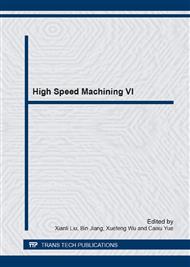[1]
M. P. Vogler, R. E. Devor, S. G. Kapoor. On the modeling and analysis of machining performance in micro-endmilling,Part I: surface generation[J]. ASME J. Manuf. Sci. Eng. 126(2004) 685-694.
DOI: 10.1115/1.1813470
Google Scholar
[2]
S.M. Son, H.S. Lim, J.H. Ahn. Effets of the friction coefficient on the minimum cutting thickness in micro cutting[J]. International Joumal of Machine Tools & Manufacture. 45 (2005)529-535.
DOI: 10.1016/j.ijmachtools.2004.09.001
Google Scholar
[3]
Z.J. Yuan,M. Zhou,S. Dong. Effect of diamond tool sharpness on minimum cutting thickness and cutting surface integrity in ultraprecision machining[J]. Joumal of Materials Processing Technology. 62(1996) 327-330.
DOI: 10.1016/s0924-0136(96)02429-6
Google Scholar
[4]
S. Shimada, N. Ikawa, H. Tanaka,Ohmori. Feasibility study on ultimate accuracy in microcutting Using Molecular Dynamics Simulation[J]. CIRP Annals-Manufacturing Technology. 42(1993) 92-94.
DOI: 10.1016/s0007-8506(07)62399-3
Google Scholar
[5]
X. Liu, R.E. Devor, S.G. Kapoor. The mechanics of machining at the microscale: assessment of the current state of the science[J]. Transaction of the ASME. 126(2004) 666-678.
DOI: 10.1115/1.1813469
Google Scholar
[6]
G. Bissacco,H. N. Hansen,J. Slunsky. Modeling the cutting edge radius size effect for force prediction in micro milling[J]. Annals of the CIRP. 57(2008) 113-116.
DOI: 10.1016/j.cirp.2008.03.085
Google Scholar
[7]
J. Ma, Limit cutting depth forecasting of mold steel milling consider the tool deformation conditions. (MS, Harbin University of Science and Technology, China 2014).
Google Scholar


